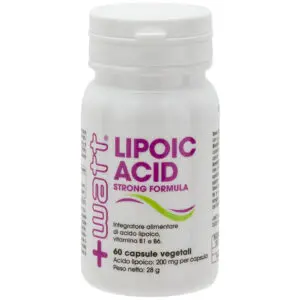Lipoic acid
Alpha-Lipoic acid (α-lipoic acid, named also thioctic acid) is an important and necessary substance for our metabolism. Our body is able to produce it, although in modest quantities. Lipoic acid is also present in animals and plants, and therefore it can be found in various foods: vegetables, such as spinach, broccoli, tomato, Brussels sprouts, potatoes and rice bran, red meats and offal.
In cells, lipoic acid is located in the mitochondria. Right there, it performs one of its main tasks: It acts as an important cofactor for many biochemical reactions indispensable in the production of energy from glucose. In addition, it allows a better control of blood glucose (glycaemia), so much so that lipoic acid is considered an “insulin-mimetic” (Diesel et al, Biochemistry, 2006). In other words, lipoic acid optimizes the action of insulin, just as Robin (α-lipoic acid) acts as a trusted shoulder of Bat-Man (insulin) in fighting crime (hyperglycaemia and insulin resistance) in Gotham City.
Secondly, lipoic acid is a very powerful antioxidant agent. It acts both as a direct antioxidant, directly inactivating free radicals and removing heavy metals from the body as an indirect antioxidant, capable of regenerating other cellular antioxidants such as glutathione, vitamin C and vitamin E (Biewenga et al, Gen Pharmacol Vasc Syst 1997).
Thanks to the many biochemical reactions in which lipoic acid is involved, various studies have been carried out on the latter on various aspects of our health and have indicated numerous roles. Particularly interesting are the studies in subjects suffering from pain from peripheral neuropathy, in which the intake of 600 mg of lipoic acid reduced the symptoms (Garcia-Alcala et al, J Diabetes Res, 2015; Agathos et al, J Int Med Res, 2018). In these cases of increased need, lipoic acid becomes conditionally essential, i.e. the endogenous production of the organism alone is unable to meet the increased demand.
In other studies, it has been suggested that lipoic acid may slow down brain aging, due to its neuroprotective role, improve cardiovascular function and protect LDL cholesterol molecules (the “bad” ones) from oxidation (Patel et al, South Med J, 2014).
In athletes there are many benefits that lipoic acid can bring: first of all, its antioxidant action protects the athlete’s tissues from excessive damage from free radicals produced during high oxygen consumption. Furthermore, its “insulin-mimetic” action can support the athlete both in managing pre-race carbohydrate loads (a practice common in some endurance sports, such as cycling), and in decreasing the risk of reactive hyperglycaemia (linked to reduction of the sense of energy) after taking carbohydrates.
Even in pregnancy, lipoic acid has shown firstly its safety for mother and unborn child and, secondly, its usefulness, in particular to alleviate symptoms of gestational peripheral neuropathy (Costantino et al, Eur Rev Med Pharmacol Sci, 2014; Parente et al, Eur Rev Med Pharmacol Sci, 2017). Obviously the intake of food supplements during pregnancy must be agreed with your gynecologist.
Which is the best way to take an α-lipoic acid supplement according to scientific data?
Absorption studies of lipoic acid have shown that it is best absorbed on an empty stomach, while a 20% reduction in bioavailability occurs when it is taken through food sources (Gleiter et al, Eur J Clin Pharmacol, 1996). On these bases it is suggested to take α-lipoic acid at least 2 hours after eating or, if taken before a meal, let 30 minutes elapse between intake of lipoic acid and the meal (Gleiter et al, Eur J Clin Pharmacol, 1996). Once assumed, the time required to reach the maximum concentrations in the blood is around 30 minutes to 1 hour (Breithaupt-Grogler et al, Eur J Pharm Sci, 1999).
+Watt Advice
Recommended use: take 400-600 mg (2-3 capsules) of α-lipoic acid with a sip of water, on an empty stomach.



